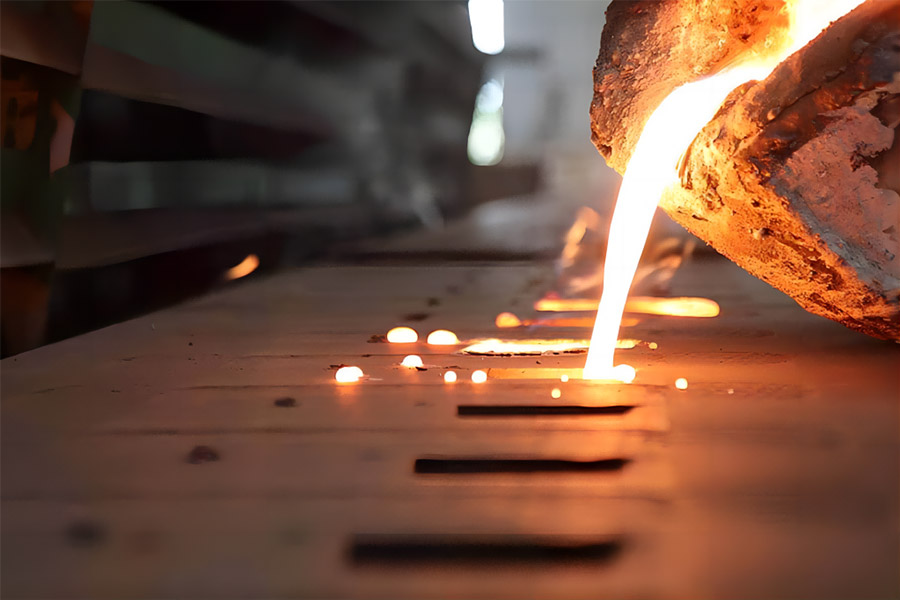Die casting is an efficient manufacturing process for producing precise, complex metal parts. Grasping the melting points of various metals is essential for this process.
This guide explores the significance of metal melting points, their role in die casting, common metals used, and the factors affecting these points.
What is a metal’s melting point?
The temperature at which a metal transitions from solid to liquid—a state in which both phases coexist in balance—is known as its melting point. This fundamental property varies among metals. For example, aluminum melts at about 660°C (1220°F) and copper at around 1085°C (1985°F).
Common Metal Melting Points
Several metals are commonly used in die casting, each with distinct melting points and characteristics:
- Aluminum (660°C or 1220°F): Due to its lightweight, corrosion resistance, and excellent thermal conductivity, aluminum is extensively used in die casting. It is ideal for automotive parts, electronics, and household appliances.
- Zinc (419°C or 786°F): Because of its low melting point, zinc is easy to cast. It provides excellent dimensional stability and high strength, making it ideal for small, intricate parts such as hardware and toys.
- Magnesium (650°C or 1202°F): As the lightest structural metal, magnesium offers a high strength-to-weight ratio. It is utilized in the aerospace, automotive, and electronics industries.
- Copper (1085°C or 1985°F): Copper and its alloys, such as brass and bronze, are used for their excellent electrical and thermal conductivity. They are suitable for electrical components and plumbing fixtures.
Here is a table detailing the melting points of common metals and their alloys used in die casting:
Metal | Alloy Model | Melting Point (°C) | Melting Point (°F) |
Aluminum | A380 | 540 - 595 | 1004 - 1103 |
A360 | 570 - 610 | 1058 - 1130 | |
A356 | 555 - 630 | 1031 - 1166 | |
A383 | 540 - 595 | 1004 - 1103 | |
ADC12 | 550 - 610 | 1022 - 1130 | |
Zinc | Zamak 3 | 380 - 387 | 716 - 728 |
Zamak 5 | 380 - 387 | 716 - 728 | |
Zamak 7 | 380 - 387 | 716 - 728 | |
Magnesium | AZ91D | 595 - 640 | 1103 - 1184 |
AM60B | 595 - 640 | 1103 - 1184 | |
AS41B | 595 - 640 | 1103 - 1184 | |
Copper | C84400 | 870 - 1020 | 1598 - 1868 |
C84800 | 870 - 1020 | 1598 - 1868 |
Factors Affecting the Melting Point of Metals
Various factors can affect the melting point of metals, including:
- Purity: Impurities in a metal can lower its melting point. High-purity metals have more consistent melting points.
- Alloying: Introducing other elements to a metal can change its melting point. For example, alloying aluminum with silicon lowers its melting point, making it more suitable for casting.
- Pressure: The melting point of metals can change under different pressure conditions. Generally, increased pressure raises the melting point.
- Crystalline Structure: The atomic arrangement within a metal’s crystalline structure can influence its melting point. Metals with a more complex structure may have higher melting points.
Importance of Understanding Metal Melting Points
Understanding the melting point of metals is vital for several reasons:
- Material Selection: Knowing the melting points helps in selecting the appropriate metal for specific die casting applications, ensuring optimal performance and cost-effectiveness.
- Process Optimization: Accurate knowledge of melting points aids in optimizing the die casting process, including temperature control, cooling rates, and cycle times.
- Quality Control: Knowing the melting points guarantees that the metal is processed at the proper temperature, reducing defects and enhancing the final product’s quality.
Measuring Metal Melting Points
Several techniques are used to measure the melting point of metals:
- Thermocouples: Thermocouples are widely used to measure temperature changes during the melting process. They provide accurate and real-time temperature readings.
- Differential Scanning Calorimetry (DSC): DSC provides accurate melting point information by measuring the heat flow related to the metal’s phase transitions.
- Visual Observation: For some metals, visual observation in a controlled environment can help determine the melting point. This method, however, is less precise than instrumental techniques.
How to Melt Metal in Die Casting
Melting metals in die casting involves several steps:
- Furnace Heating: Metals are typically melted in furnaces designed to reach the required temperatures. Commonly used furnaces include electric, gas, and induction types.
- Temperature Control: Maintaining precise temperature control is crucial to ensure the metal reaches and stays at its melting point without overheating.
- Pouring into Molds: After melting, the metal is poured into pre-designed molds to form the desired shapes.The molds are often pre-heated to avoid thermal shock.
- Cooling: Following pouring, the metal must cool and solidify within the mold. Controlled cooling guarantees the desired structural properties and reduces the risk of defects.
- Finishing: Post-cooling, the cast parts are removed from the molds and may undergo finishing processes such as trimming, polishing, or machining to achieve the final specifications.
Conclusion
Comprehending the melting points of metals is essential for successful die casting. It affects material selection, process optimization, and the overall quality of the product. By comprehensively understanding and managing melting points, manufacturers can enhance their die casting operations, leading to better performance, cost savings, and superior end products.

